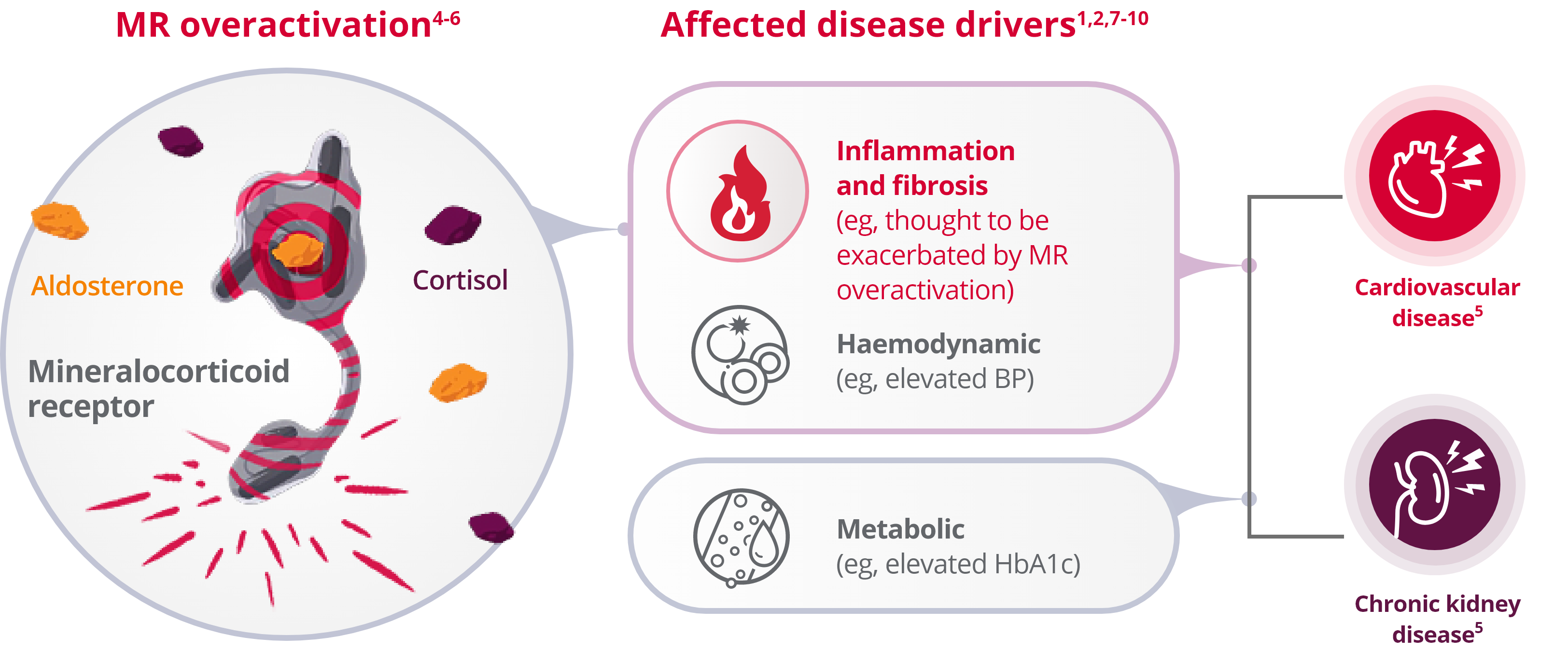Despite standard of care, a key risk factor remains largely unaddressed in patients with CKD and T2D1-3

MR overactivation contributes to several pathophysiological mechanisms including5:
- Sodium retention
- Extracellular matrix remodeling and hypertrophy
- Inflammation and fibrosis
Your patients need protection against MR overactivation
Firialta is the first and only selective MRA approved to treat CKD and T2D6
With no affinity to other hormone receptors, Firialta selectively blocks6,11:
- MR overactivation
- MR-mediated sodium reabsorption
- Expression of pro-inflammatory and pro-fibrotic mediators
Firialta selectively and potently blocks MR overactivation in the heart and kidneys11
Selected characteristics of 2 classes of MRAs12-14
Characteristic
Potency to MR*
Selectivity to MR*
Metabolites*
Half-life
(~2 to 3 hours)
(>20 hours)
(4 to 6 hours)
Distribution (rodent model)
(≥6-fold)
(~3-fold)
Risk of hyperkalaemia
Effects on blood pressure
Firialta is indicated for adults with CKD associated with T2D to reduce the risk of sustained eGFR decline, ESKD, CV death, non-fatal MI, and hospitalisation for HF. Spironolactone is indicated for congestive cardiac failure, hepatic cirrhosis with ascites and oedema, malignant ascites, nephrotic syndrome, and diagnosis and treatment of primary hyperaldosteronism. Eplerenone is indicated in addition to standard therapy including beta-blockers, to reduce the risk of cardiovascular mortality and morbidity in stable patients with left ventricular dysfunction (≤40%) and clinical evidence of heart failure after recent myocardial infarction.6,15,16
*Based on preclinical animal models. The clinical consequences of these characteristics are unknown.17
BP=blood pressure; CKD=chronic kidney disease; CV=cardiovascular; eGFR=estimated glomerular filtration rate; ESKD=end-stage kidney disease; HbA1c=glycated haemoglobin; HF=heart failure; MI=myocardial infarction; MR=mineralocorticoid receptor; MRA=mineralocorticoid receptor antagonist; SBP=systolic blood pressure; T2D=type 2 diabetes.
References:
- Alicic RZ, et al. Adv Chronic Kidney Dis. 2018;25(2):181-191. doi:10.1053/j.ackd.2017.12.002. Return to content
- Alicic RZ, et al. Clin J Am Soc Nephrol. 2017;12(12):2032–2045. Return to content
- Bakris GL, et al; FIDELIO-DKD Investigators. N Engl J Med. 2020;383(23):2219-2229. doi:10.1056/NEJMoa2025845. Return to content
- Bauersachs J, et al. Hypertension. 2015;65(2):257-263. Return to content
- Kolkhof P, et al. Pharmacol Res. 2021;172:1-13. doi:10.1016/j.phrs.2021.105859. Return to content
- Firialta® Product Insert approved by NPRA 4th April 2024. Return to content
- Kidney Disease: Improving Global Outcomes (KDIGO) Diabetes Work Group. Kidney Int. 2020;98(4S):S1-S115. Return to content
- Toth-Manikowski S, et al. J Diabetes Res. 2015;2015. doi:10.11552015/697010. Return to content
- Black LM, et al. J Histochem Cytochem. 2019;67(9):663-681. doi:10.1369/0022155419852932. Return to content
- Tesch GH, et al. Front Pharmacol. 2017;8:313. doi:10.3389/fphar.2017.00313. Return to content
- European Medicines Agency. Committee for Medicinal Products for Human Use (CHMP) Assessment report. Firialta. https://www.ema.europa.eu/ en/documents/assessment-report/ firialta-epar-public-assessment- report_en.pdf. December 2021. Accessed August 31, 2022. Return to content
- Kintscher U, et al. Br J Pharmacol. 2022;179:3220–3234. Return to content
- Kolkhof P, et al. Handb Exp Pharmacol. 2017;243:271-305. doi:10.1007/164_2016_76. Return to content
- Pitt B, et al. Eur Heart J. 2013;34(31):2453-63. doi:10.1093/eurheartj/eht187. Return to content
- ALDACTONE (spironolactone) [prescribing information]. New York, NY: Pfizer; February 2021. Return to content
- INSPRA (eplerenone) [prescribing information]. New York, NY: Pfizer; August 2020. Return to content
- Fagart J, et al. J Biol Chem. 2010;285(39)-29932-29940. doi:10.1074/jbc.M110.131342. Epub 2010 Jul 22. Return to content


